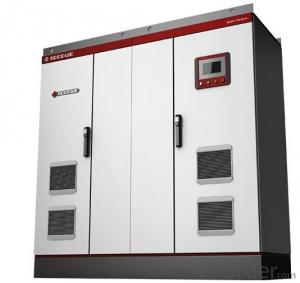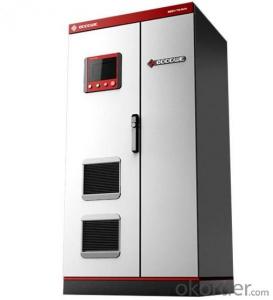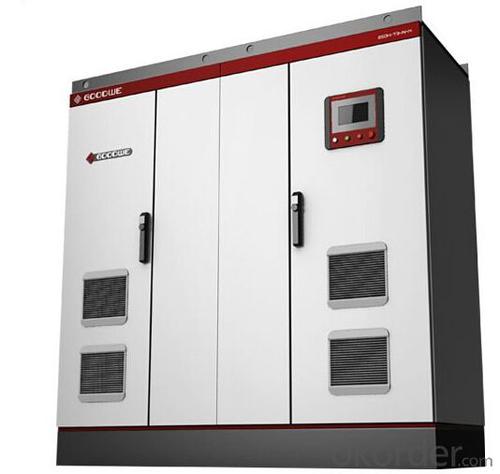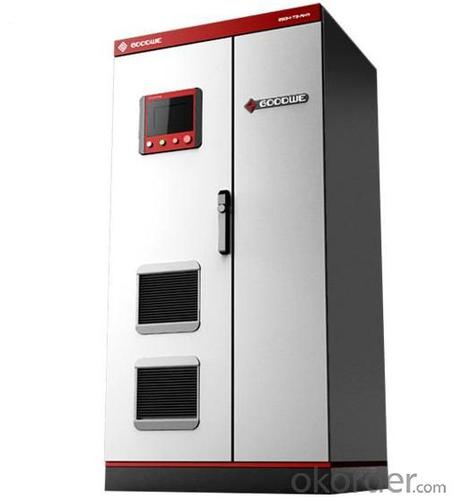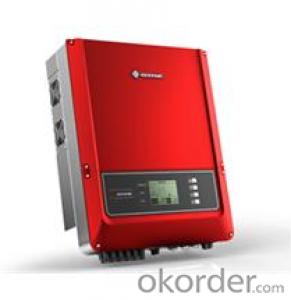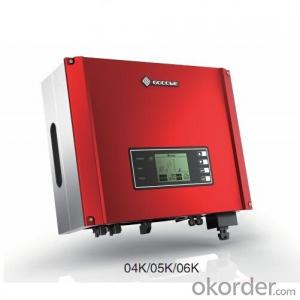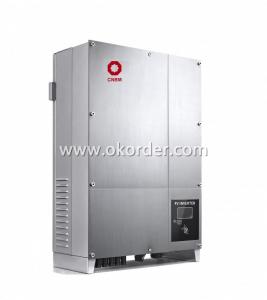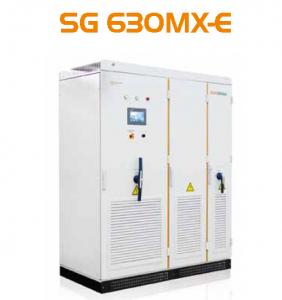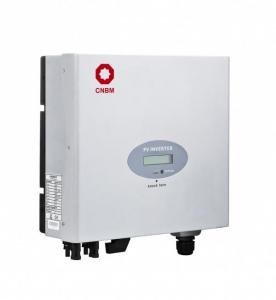Hvrt On Grid Solar Inverter GW250K-MT
OKorder Service Pledge
OKorder Financial Service
You Might Also Like
Central solar inverter GW250K-MT inverters have wide application in commercial and industrial rooftop projects and small/middle size commercial solar power plants. The inverter adopts mature transformer isolation technology which minimizes output DC component effectively; advanced LVRT technology can meet any requirement of power plant grid integration, the products can be installed and applied in all types of grid network. At the mean while, the harsh quality testing and production system of the company provide strongest safeguard for 'GoodWe quality', product stability and reliability.
Datasheet
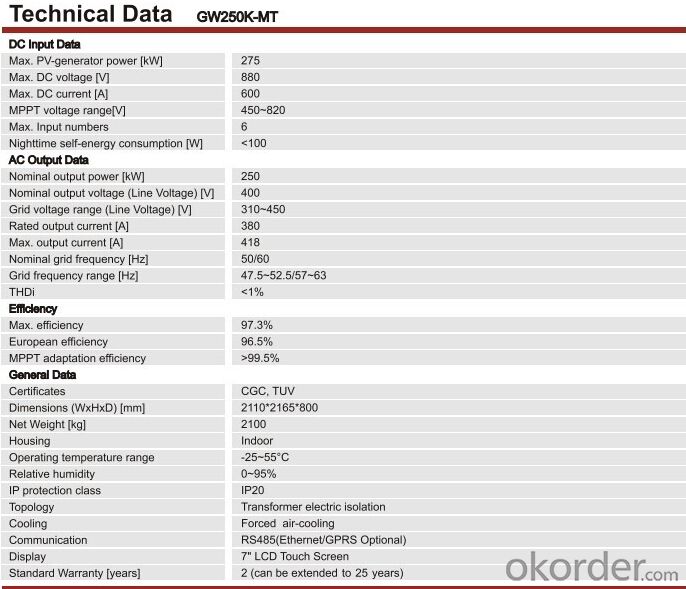
- Q: What is the typical lifespan of the capacitors in a solar inverter?
- The typical lifespan of capacitors in a solar inverter can vary depending on various factors such as the quality of the components used, the operating conditions, and the amount of stress placed on the capacitors. However, on average, the lifespan of capacitors in a solar inverter can be expected to be around 10 to 15 years. Capacitors are electronic components that store and release electrical energy, and they play a crucial role in the functioning of a solar inverter. They help regulate voltage, smooth out fluctuations in power, and provide stability to the electrical system. The lifespan of capacitors in a solar inverter is influenced by several factors. One of the most significant factors is the quality of the capacitors themselves. Higher quality capacitors tend to have better performance and durability, resulting in a longer lifespan. Cheaper or lower-quality capacitors may degrade or fail more quickly. Another factor that affects the lifespan of capacitors is the operating conditions. Solar inverters are typically installed outdoors, exposed to temperature variations, moisture, and other environmental factors. Extreme temperatures, excessive humidity, or exposure to direct sunlight can potentially accelerate the deterioration of capacitors and reduce their lifespan. Additionally, the stress placed on the capacitors can impact their lifespan. This stress can be caused by factors such as voltage fluctuations, high-frequency switching, or overloading of the inverter. If a solar inverter is operated beyond its design limits or experiences frequent power fluctuations, it can put additional strain on the capacitors, potentially leading to premature failure. Regular maintenance and monitoring of the solar inverter can help identify any potential issues with the capacitors and address them promptly. Some manufacturers may offer warranties or provide information on the expected lifespan of their capacitors, which can give an indication of their durability. In summary, the typical lifespan of capacitors in a solar inverter is around 10 to 15 years, but this can vary depending on factors such as component quality, operating conditions, and stress placed on the capacitors. Regular maintenance and monitoring can help ensure the longevity and optimal performance of the capacitors in a solar inverter system.
- Q: Can a solar inverter be used with different monitoring platforms?
- Yes, a solar inverter can be used with different monitoring platforms as long as the monitoring platforms are compatible with the inverter's communication protocols and data formats.
- Q: How does a solar inverter handle variations in solar panel degradation over time?
- A solar inverter is designed to handle variations in solar panel degradation over time by continuously monitoring the output of the solar panels and adjusting its operation accordingly. It helps to optimize the power generation by compensating for any decrease in panel efficiency due to degradation. This is achieved through advanced algorithms and maximum power point tracking (MPPT) technology, which ensures that the inverter operates at the optimal voltage and current levels to extract the maximum power from the panels, even as their performance degrades over time.
- Q: Can a solar inverter be used in a hybrid solar system?
- Yes, a solar inverter can be used in a hybrid solar system. A hybrid solar system combines solar power with other sources of energy, such as batteries or a backup generator. The solar inverter is responsible for converting the DC electricity generated by the solar panels into AC electricity that can be used to power appliances and other electrical devices. In a hybrid system, the solar inverter works in conjunction with other components, such as a battery inverter or a grid tie inverter, to manage the flow of electricity between the solar panels, batteries, and the electrical grid.
- Q: How does a solar inverter handle variations in solar panel tilt and orientation?
- A solar inverter handles variations in solar panel tilt and orientation by continuously monitoring the output voltage and current of the solar panels. It then adjusts the power conversion process to optimize the efficiency of power generation based on the tilt and orientation of the panels. This ensures that maximum power is extracted from the solar panels regardless of their position, allowing for optimal energy production.
- Q: How does a hybrid solar inverter work?
- A hybrid solar inverter works by converting the direct current (DC) power generated by solar panels into alternating current (AC) power that can be used to power household appliances or be fed back into the grid. It also has the capability to store excess energy in batteries for later use during periods of low solar generation or power outages. This allows for efficient utilization of solar energy and provides backup power when needed.
- Q: How do you choose the right input voltage range for a solar inverter?
- When choosing the right input voltage range for a solar inverter, it is essential to consider the specifications and requirements of the specific solar panels being used. The input voltage range should be compatible with the voltage output of the solar panels to ensure optimal performance and efficiency. Additionally, factors such as the system size, installation location, and local regulations should also be taken into account to determine the appropriate input voltage range for the solar inverter.
- Q: Generally a large grid-connected photovoltaic power plant will have several inverters
- Inverter, a single failure, does not affect other operations, the impact on the grid is small, high reliability.
- Q: Can a solar inverter be used with different types of energy management systems?
- Yes, a solar inverter can be used with different types of energy management systems. Solar inverters are designed to convert the direct current (DC) generated by solar panels into alternating current (AC) that can be used to power various electrical devices. They are compatible with different energy management systems, including grid-tied systems, off-grid systems, and hybrid systems. The inverter's main function is to ensure the efficient and safe conversion of solar energy, regardless of the type of energy management system it is paired with.
- Q: Can a solar inverter be used with solar-powered data centers?
- Yes, a solar inverter can be used with solar-powered data centers. In fact, solar inverters are essential components in solar power systems as they convert the direct current (DC) generated by the solar panels into alternating current (AC) which is then used to power the data center's equipment. The solar inverter ensures efficient and reliable utilization of solar energy in data centers.
Send your message to us
Hvrt On Grid Solar Inverter GW250K-MT
OKorder Service Pledge
OKorder Financial Service
Similar products
Hot products
Hot Searches
Related keywords
